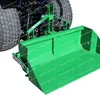Others agricultural implements are an essential category of farming tools that enhance productivity, efficiency, and sustainability in modern agriculture. These implements include a wide range of equipment beyond standard machinery, designed to handle specialized tasks such as soil preparation, planting, cultivation, harvesting, and post-harvest processing. With advancements in technology, these implements have evolved to meet the demands of diverse farming environments, offering robust performance, durability, and user-friendly features. This detailed SEO content provides comprehensive information on product parameters, presented in lists and tables for clarity, along with a FAQ section to address common queries.
Others agricultural implements encompass various subcategories, each tailored to specific agricultural operations. Below is an overview of the primary types available:
To assist in selecting the right implement, here are key parameters for popular others agricultural implements, presented in a structured table format. These specifications cover dimensions, weight, material, power requirements, and usage recommendations.
| Implement Type | Model | Dimensions (LxWxH in cm) | Weight (kg) | Material | Power Requirement (HP) | Recommended Use |
|---|---|---|---|---|---|---|
| Subsoiler | SS-500 | 200x150x100 | 250 | High-carbon steel | 50-70 | Deep tillage for compacted soils |
| Seed Drill | SD-300 | 300x120x150 | 180 | Galvanized steel | 30-40 | Precision seeding for grains |
| Cultivator | CULT-200 | 250x100x90 | 120 | Alloy steel | 20-30 | Weed control and soil aeration |
| Reaper | RP-400 | 350x180x200 | 300 | Stainless steel | 40-60 | Harvesting cereals and pulses |
| Grain Dryer | GD-250 | 200x150x250 | 220 | Mild steel with coating | 15-25 (electric) | Moisture reduction for storage |
Additional parameters to consider include compatibility with tractor hitches, maintenance intervals, and warranty periods. For instance, most implements require regular lubrication and inspection of moving parts to ensure longevity. Always refer to the manufacturer's guidelines for specific details.
Incorporating these implements into farming operations offers numerous benefits:
Here are some frequently asked questions about others agricultural implements, with detailed answers to guide users.
What are the key factors to consider when choosing an others agricultural implement?
Factors include the type of crop, soil conditions, available power source (e.g., tractor HP), implement size, material durability, and budget. It's also important to assess compatibility with existing machinery and ease of maintenance.
How often should others agricultural implements be maintained?
Maintenance frequency depends on usage intensity, but generally, implements should be inspected before each use for wear and tear. Lubricate moving parts weekly during peak seasons, and perform a thorough cleaning and storage preparation after harvest to prevent rust and damage.
Can these implements be used with any tractor model?
Not necessarily. Implements are designed for specific hitch systems (e.g., three-point hitch) and power ranges. Always check the implement's specifications for compatible tractor HP and hitch type to ensure safe and efficient operation.
Are there safety precautions to follow when operating others agricultural implements?
Yes, always wear protective gear like gloves and goggles, ensure all guards are in place, and operate on level ground to avoid tipping. Follow the manufacturer's instructions for setup and use, and keep bystanders away during operation to prevent accidents.
What is the average lifespan of these implements?
With proper maintenance, high-quality implements can last 10-15 years or more. Factors affecting lifespan include material quality (e.g., corrosion-resistant steel), frequency of use, and adherence to maintenance schedules.
Do others agricultural implements come with a warranty?
Most reputable manufacturers offer warranties ranging from 1 to 5 years, covering defects in materials and workmanship. Be sure to register the product and keep proof of purchase to avail warranty services.
How do I store others agricultural implements when not in use?
Clean implements thoroughly to remove dirt and debris, apply a rust inhibitor if necessary, and store in a dry, covered area. Disconnect from power sources and avoid stacking to prevent damage to delicate parts.
Can these implements be customized for specific farming needs?
Yes, many manufacturers offer customization options for attachments, sizes, and features. Discuss your requirements with the supplier to tailor implements for unique crops or terrain conditions.
What is the energy consumption of electric-powered others agricultural implements?
Energy consumption varies by model; for example, a grain dryer might use 15-25 kW per hour. Check the product specifications for exact power ratings and consider energy-efficient models to reduce electricity costs.
Are there training resources available for using these implements?
Yes, manufacturers often provide manuals, video tutorials, and on-site training. Additionally, agricultural extension services and online forums offer guidance on best practices for operation and troubleshooting.




